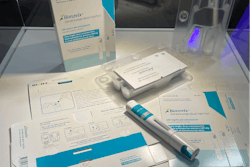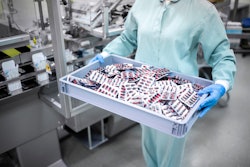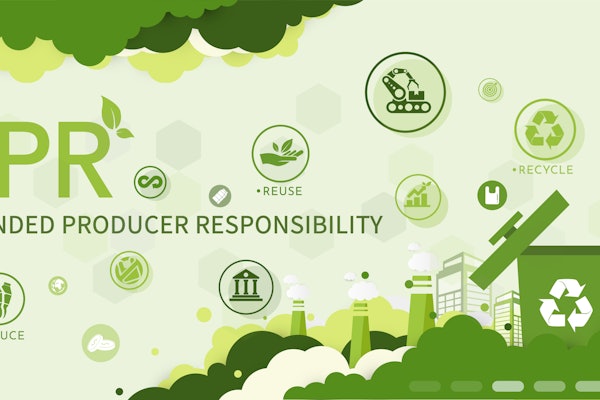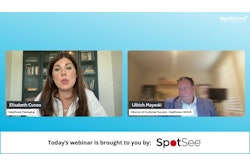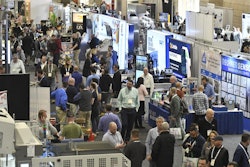Liz Cuneo: Hello. Allow me to introduce Wendy Mach. Wendy Mach is a packaging and sterilization expert at Canyon Labs. Hello, Wendy. Thank you for joining me.
Wendy Mach: Hi Liz, good to see you.
Liz Cuneo: Good to see you too. So yeah, let's dive in. I know we spoke a little bit before, you know, kind of teeing up this video interview. But you had mentioned that the EPA recently announced, kind of a concentration limit, establishing a concentration limit of 600 milligrams per liter for new medical device sterilization cycles within 10 years. And you said this was good news, because some MDMs were worried that they'd have to get under 400. So I thought maybe you could elaborate, you know, why the 600 and not the 400, and what kind of what that means for the industry?
Wendy Mach: Sure. So again, this is going to be my personal opinion, right? But I think that the reason that the industry, the EPA went with 600 milligrams versus 400 milligrams is more like a reflection between balancing the sterilization efficacy and then the safety of the environment and the Clean Air Act.
A lot of the companies currently are validated using like 640, 650; I've seen that as a very common concentration. And so the challenge to bring it down to that 400 level is a lot more work on behalf of the medical device companies, whereas The 600 is just a little bit about optimizing the cycle parameters, and is a lot easier to get to than 400. When we're talking 400, we're looking at potentially outlet configuration changes, potentially understanding how to change the density of the loads, decreasing the concentration, increasing aeration times.
There's a lot more validation work that goes into it when we're that much lower. So I think that the combination of industry participating in these town hall meetings, and that type of influx, actually is what helped drive where those numbers actually came from.
Liz Cuneo: Okay, do you think it's fair to say that the industry could eventually go to 400 or the EPA would ever mandate that maybe in another 10 years?
Wendy Mach: Oh, that's a really great question. Honestly, I don't think so. With the contract sterilization facilities moving to a 90% recovery value for the emissions or more, by bringing in those changes to the facilities, and then setting the 600 limits, I think that that will meet the EPA's requirements for the Clean Air Act, and hopefully we can move into a more harmonized future around that.
Liz Cuneo: Okay, excellent. So you mentioned optimization of sterilization cycles. Can you describe what that means? And maybe what are the, you know, top three ways that companies can optimize their cycles?
Wendy Mach: Sure. So, optimizing your cycle is about adjusting some of the test parameters and specifications, but yet continuing to maintain that desired SAL level.
I think first, when you're optimizing, you want to make sure that you understand where you're at today. A lot of times, these companies went forward with overkill cycles, and I mean, we're talking like, way overkill. There was one project that I worked on that actually, when we sat down and did the calculation, the SAL actually ended up being like a 10 to the minus 56. But that was really because that's the way we did it. And when we actually sat back and looked at the process, we found out that a four hour cycle really wasn't necessary for these types of products, that we could drop it down to, say maybe an hour or two.
So I feel like industry pretty much fit into this curve, and we just, if you were able to execute under the cycle, then everybody just went with it, assuming that their EO residuals were okay. Now stepping back, there's a lot more thought process into it. It's understanding what the bio burden level is on your product. Do you need to have that much of an exposure cycle? Understanding that the gas can have issues with the materials and damage the materials. Again, bringing back those different types of parameters. And then again, flexibility around these efficiencies.
So those would be really the top three for me, making sure you understand what your true SAL level needs to be, making sure that you're minimizing the damage to your product, if at all, and then understanding those residual levels.
Liz Cuneo: Okay, great. Yeah, it sounds like it's really about knowing your product and what you actually need to accomplish during sterilization. Yeah, and you mentioned EO, too. And I know there's, you know, I don't know if it's controversy, but there's some topic about, is that really the best choice? And I read some more that some medical devices can only safely be treated using EO. Is that true? Or are there alternatives that maybe could be a viable choice in the future?
Wendy Mach: Yeah, so EO is not going to go away. I mean, the fact of the matter is that there are some medical devices that are uniquely suited for specifically ethylene oxide because of the way it's made or the design features. Those are really reasons why it's never going anywhere. However, if there are device geometries and things like that, packaging considerations, there is the option for these different alternative modalities that you can start exploring.
We're starting to see a lot in the chlorine dioxide space. VHP now that has come out with an official standard, is definitely starting to take off. I recently heard the majority of hospitals are taking out their EO sterilizers and replacing them with VHP units.
So there's also supercritical carbon dioxide. That's a mouthful, that's definitely coming to market. And then we always have the irradiation approaches, with the E beam and X-ray coming to market. So there's a lot more choices, but I feel like they're a small niche in industry, in that the EO actually does meet a wide variety of products that have complications associated with those alternative modalities.
Liz Cuneo: Excellent. Someone I recently spoke with said that the challenge within sterilization is really that there's not enough facilities to handle the amount of sterilizing that many companies need, or you know, have available to them. Do you agree with that, and why do you think that is?
Wendy Mach: So capacity, right? Supply and capacity, it is an issue. And I think as we continue to grow in medical devices, that will still continue to be capacity issues.
I believe that the changes and the focus on the ethylene oxide really brought that to light. I think they were really there already. It's just they're a lot more visible now, because unfortunately, some facilities are shutting down. There are new facilities coming on board, like NextBeam and Steris is investing in all these other different X-ray and those kinds of processes. So this focus has actually caused the main sterilization facilities to actually start thinking about expanding and bringing other modalities on board, rather than just the EO, if they had that, as their main focus.
So there is expansion capabilities and opportunities that are out there, and they are being explored. I've heard it from the majority of the big contract sterilizers, that they're building this and they're building that. So the focus is to try to get that supply chain, have more availability, but they have to keep up with growth, right? So as we're bringing more and more medical devices, as the population increases, we're using more and more medical devices. It's just kind of like a catch-24 it just keeps going, and we need to grow with it.
Liz Cuneo: Yes. So that kind of brings me to another question. You had mentioned that the burden is really on the contract sterilizers, not the MDMs when talking about optimizing cycles, and, you know, adhering to sterilization regulations. Does that mean that the MDMs don't really have to worry about the issue of sterilization? Is that really top of mind for them, or is it really a contract sterilizer top-of-mind issue?
Wendy Mach: I would say it's a 60/40. So the reason I say 60/40 is that the burden from a monetary aspect, is really on the contract sterilizers. The end result is they're the ones that have to comply with the EPA requirements around the fugitive emissions and bringing all of those upgrades into their facility to bring those levels down, and it's not a small amount of money, it's millions and millions of dollars.
Now, the 40% falls on the med device, because in order for these contract sterilizers to meet these requirements, not only is it about upgrading the facilities and bringing this equipment up and online, it's also about reducing these cycles so that the workers that are exposed to these conditions are not being exposed to that the levels that they were at. So it also applies to med device that way that they're needing to think about the cycles and, if they can, reduce that amount of gas that the product is seeing. So it comes back, everything is very much related, I think you can see. But in the end, again, the burden is actually really on the contract sterilizers to reduce that in accordance with EPA.
Liz Cuneo: Okay, cool. So I know you were at the recent KILMER Conference, and one topic that came out of that was oxidative induction time, OIT, studies for medical devices. I'm wondering if you could tell us a little bit about what that means and how prevalent it is in the industry.
Wendy Mach: Sure. So at the Kilmer conference that was hosted by AAMI this year, we had a great time. One of the presentations put on was about oxidative induction time around packaging. So this is actually led by a Wicked Stability Group, Breaking Bad Biases, and their goal is to reduce the amount of package testing that med device companies are doing currently.
So right now, we have standards out there that state that you need to do accelerated aging and integrity and strength testing on all of these different configurations, and then if you make a change, you do a risk assessment, and likely end up doing more testing. And all these companies are doing the same testing because packaging materials are very finite, right? We all know there's Tyvek, paper, plastics and things like that. So everybody's doing the same testing over and over and over again and looking for device/material interactions and if they change over time.
So what we're doing with OIT is we're using these oxidative induction time studies to demonstrate that over time, these materials actually don't change, and that the changes or failures that we're seeing are actually event related; something happens. It's not about the material changing. It's about like, 'I accidentally dropped it, or it got damaged during shipping,' those types of things.
So we're hoping that this methodology will demonstrate that over time, there is no change in the materials, and therefore the requirement to do this type of testing over and over and over again can be reduced. We're a long way from being able to prove that right now. We have a massive study going on with evaluating the impact of ethylene oxide and different levels of gamma sterilization on these materials, and we're just using LDPE right now, but it needs to be a bigger study. We need more people to be involved, to look at different materials.
It also involves looking at bringing in regulatory environment and speakers, like we've had the FDA involved. We've had TÜV SÜD, all different types of regulatory officials to make sure that we're going in the right direction. Because the last thing you want to do is spend all this money and time, and I'm pretty sure we're three years into this already, and then not get to the end, have this great data, demonstrate that our hypothesis is accurate, and they say, 'we don't care.' So we're bringing them along with us.
Liz Cuneo: Yeah, that's great. So it sounds like, is it fair to say the end goal is to reduce the amount of testing these materials have to, I guess, prove over and over that they're, you know, they're capable and they can help hold up in certain scenarios? Just limit that, you know, saves time, save money, I'm assuming, just get these products maybe out on the market quicker?
Wendy Mach: That, and it will free up our engineers to start working on other projects that can bring patient safety and new devices to market, also. Because, if they're off running the same tests over and over and over again, just because, we're not bringing new devices to market.
Liz Cuneo: Okay, great, awesome. Yeah, I'll have to look for more on that topic, maybe at another conference, or just on LinkedIn. I'll see if there's any more information about that. That's great.
Wendy Mach: Yep, we actually have a good presentation coming up very soon at a speaking event for The PACKout. Not sure if I can tell you where that is or not.
Liz Cuneo: Actually, I'll be there.
Wendy Mach: Great. Yeah, The PACKOut's, it's actually kind of fun, because the team has put out a little teaser that there's one data point in there that's going to be very interesting to discuss. So more to come on that.
Liz Cuneo: Cool. Yes, I'll be there. Maybe we'll do a follow up interview after that event. That'd be cool.
Wendy Mach: Yeah, that'd be fun.
Liz Cuneo: Okay, cool. Well, thank you, Wendy, for your time today.
Wendy Mach: You're welcome. It was nice talking with you, Liz.
Liz Cuneo: You too.



